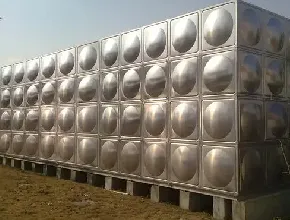loading...
- No. 9, Xingyuan South Street, Dongwaihuan Road, Zaoqiang County, Hengshui, Hebei, China
- admin@zjcomposites.com
- +86 15097380338
- Welcome to visit our website!
sand filter frp
Understanding Sand Filters and FRP An Efficient Water Treatment Solution
Water is a crucial resource for life, yet ensuring its cleanliness is a persistent challenge faced by many industries. Among various water treatment solutions, sand filtration remains one of the most efficient methods of purifying water, especially when combined with Fiber-Reinforced Plastic (FRP) technology. This article delves into the intricacies of sand filters and the role FRP plays in enhancing their efficacy and durability.
What is a Sand Filter?
A sand filter is a type of water treatment system that uses granular materials, primarily sand, to remove sediment, turbidity, and other impurities from water. Sand filters operate on the principle of physical filtration, where water passes through layers of sand. As it flows through, contaminants are trapped in the sand, resulting in cleaner water on the other side.
The design and operation of sand filters vary depending on their specific applications—ranging from small household systems to large-scale industrial setups. Typically, a sand filter consists of a reservoir filled with varying sizes of sand grains, allowing for multiple stages of filtration, which enhances efficiency.
Advantages of Sand Filters
Sand filters offer several advantages 1. Cost-Effectiveness They are relatively inexpensive to construct and maintain compared to other filtration technologies. 2. Simplicity and Reliability The operation of sand filters is straightforward, typically requiring minimal supervision. 3. Environmental Friendliness Sand filters use natural materials and often can work without the need for chemical additives, making them an environmentally friendly option.
However, traditional sand filters do come with limitations, particularly concerning their susceptibility to wear and environmental factors. This is where the incorporation of Fiber-Reinforced Plastic (FRP) comes into play.
The Role of FRP in Sand Filters
Fiber-Reinforced Plastic (FRP) is a composite material made from a polymer matrix reinforced with fibers, usually glass or carbon. FRP offers a unique combination of strength, durability, and resistance to corrosion, making it an ideal material for various applications, including water treatment systems.
sand filter frp

By integrating FRP into the design of sand filters, manufacturers can significantly enhance their usability and lifespan. Here are some key benefits of using FRP in sand filter construction
1. Corrosion Resistance Unlike traditional materials like steel that can corrode over time when exposed to water and various chemicals, FRP maintains its integrity. This resistance prolongs the life of the sand filter, reducing replacement costs and downtime.
2. Lightweight and Easy Handling FRP is considerably lighter than metals or concrete, making it easier to transport and install. This characteristic is particularly beneficial for large-scale systems that require significant manpower for setup.
3. Structural Strength Despite being lightweight, FRP can withstand considerable pressure and stress, making it suitable for high-capacity sand filters used in municipal and industrial applications.
4. Design Flexibility FRP can be molded into various shapes and sizes, allowing for innovative designs that optimize the filtration process. This flexibility enables manufacturers to create customized solutions tailored to specific water treatment needs.
5. Improved Efficiency The composite nature of FRP allows for better thermal and chemical stability, which can lead to improved performance of the filtration system overall. With enhanced durability, these filters can maintain consistent operational efficiency over time.
Conclusion
Sand filters remain a vital component of water treatment systems due to their effectiveness and cost-efficiency. However, the integration of Fiber-Reinforced Plastic enhances their performance, durability, and adaptability, ushering in a new era of water purification technology. As industries increasingly seek sustainable and efficient solutions, the combination of sand filtration and FRP stands out as a leading choice.
In summary, the evolution of sand filters with FRP technology not only optimizes water treatment processes but also contributes to greater environmental sustainability. As we strive for cleaner water sources, embracing innovative materials like FRP in traditional water treatment methods will be crucial for addressing global water challenges.
-
The Rise of FRP Profiles: Strong, Lightweight, and Built to LastNewsJul.14,2025
-
SMC Panel Tanks: A Modern Water Storage Solution for All EnvironmentsNewsJul.14,2025
-
GRP Grating: A Modern Solution for Safe and Durable Access SystemsNewsJul.14,2025
-
Galvanized Steel Water Tanks: Durable, Reliable, and Ready for UseNewsJul.14,2025
-
FRP Mini Mesh Grating: The Safer, Smarter Flooring SolutionNewsJul.14,2025
-
Exploring FRP Vessels: Durable Solutions for Modern Fluid HandlingNewsJul.14,2025
-
GRP Structures: The Future of Lightweight, High-Performance EngineeringNewsJun.20,2025
